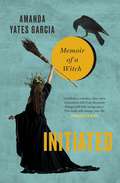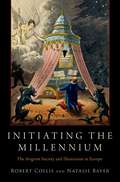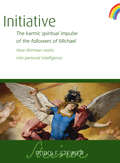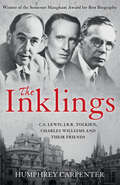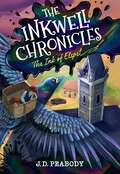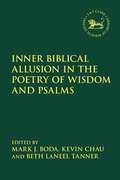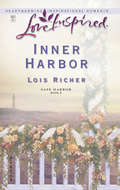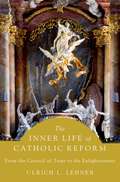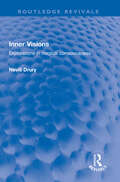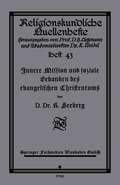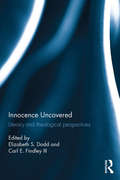- Table View
- List View
Initiated: Memoir of a Witch
by Amanda Yates GarciaAn initiation signals a beginning: a door opens and you step through. Some traditions dictate that a witch be initiated through a formal ceremony complete with rose wands, red candles, and sacred chants. But even though Amanda Yates Garcia's mother initiated her into the goddess-worshipping practice of witchcraft when she was thirteen years old, Amanda's true life as a witch only began when she underwent a series of spontaneous initiations of her own.Descending into the underworlds of poverty, sex work and misogyny, Initiated describes Amanda's journey to return to her body, harness her natural power, and finally reclaim her witchcraft to create the magical world she envisioned. Hailed by crows, seduced by malicious spirits and haunted by ancestors broken beneath the wheels of patriarchy, Amanda adventured across the globe. On the way, she survived abuse, resisted societal expectations and struggled to create intimacy - all while grappling with the question: is it possible to live a life of beauty and integrity in a world that feels like it's dying?Peppered with mythology, tales of the goddesses and magical women throughout history, Initiated stands squarely at the intersection of witchcraft and feminism. Amanda shows that practising magic is about more than spells and potions; magic is nothing less than claiming power for oneself and taking back our planet in the name of Love. Initiated is both memoir and manifesto, calling the magical people of the world to take up their wands, be brave, and create the enchanted world they long to live in.
Initiating the Millennium: The Avignon Society and Illuminism in Europe (Oxford Studies in Western Esotericism)
by Robert Collis Natalie BayerIn Initiating the Millennium, Robert Collis and Natalie Bayer fill a substantial lacuna in the study of an initiatic society--known variously as the Illuminés d'Avignon, the Avignon Society, the New Israel Society, and the Union--that flourished across Europe between 1779 and 1807. Based on hitherto neglected archival material, this study provides a wealth of fresh insights into a group that included members of various Christian confessions from countries spanning the length and breadth of the Continent. The founding members of this society forged a unique group that incorporated distinct strands of Western esotericism (particularly alchemy and arithmancy) within an all-pervading millenarian worldview. Collis and Bayer demonstrate that the doctrine of premillennialism--belief in the imminent advent of Christ's reign on Earth--soon came to constitute the raison d'être of the society. Using a chronological approach, the authors chart the machinations of the leading figures of the society (most notably the Polish gentleman Tadeusz Grabianka). They also examine the way in which the group reacted to and was impacted by the tumultuous events that rocked Europe during its twenty-eight years of existence. The result is a new understanding of the vital role played by the so-called Union within the wider millenarian and illuministic milieu at the close of the eighteenth century and beginning of the nineteenth century.
Initiating the Millennium: The Avignon Society and Illuminism in Europe (Oxford Studies in Western Esotericism)
by Robert Collis Natalie BayerIn Initiating the Millennium, Robert Collis and Natalie Bayer fill a substantial lacuna in the study of an initiatic society--known variously as the Illuminés d'Avignon, the Avignon Society, the New Israel Society, and the Union--that flourished across Europe between 1779 and 1807. Based on hitherto neglected archival material, this study provides a wealth of fresh insights into a group that included members of various Christian confessions from countries spanning the length and breadth of the Continent. The founding members of this society forged a unique group that incorporated distinct strands of Western esotericism (particularly alchemy and arithmancy) within an all-pervading millenarian worldview. Collis and Bayer demonstrate that the doctrine of premillennialism--belief in the imminent advent of Christ's reign on Earth--soon came to constitute the raison d'être of the society. Using a chronological approach, the authors chart the machinations of the leading figures of the society (most notably the Polish gentleman Tadeusz Grabianka). They also examine the way in which the group reacted to and was impacted by the tumultuous events that rocked Europe during its twenty-eight years of existence. The result is a new understanding of the vital role played by the so-called Union within the wider millenarian and illuministic milieu at the close of the eighteenth century and beginning of the nineteenth century.
INITIATION SCIENCE: and the Development of the Human Mind
by Rudolf SteinerIn an astonishing series of lectures on the science of spiritual knowledge, Rudolf Steiner begins by addressing an audience in Dornach, Switzerland – where, only months earlier, his architectural masterpiece, the first Goetheanum, had been destroyed by fire. He discusses the nature of our planetary system, revealing the planets that are characterised by freedom and those that determine destiny. The spirits of the moon live in seclusion, preserving ‘original wisdom’ and reflecting powers connected to sexuality, whereas the sun creates harmony. Jupiter is ‘the thinker’, whilst the spirits on Saturn act as ‘living memory’. Speaking in London, Steiner states that the things that happen to people in sleep are more important than anything that occurs during waking hours! Human beings, he says, must learn to see themselves as an image of spirits and spiritual activities on earth.In a break from the theme, and returning to Dornach, Rudolf Steiner reports on his recent visit to England and Wales, where he attended an educational conference in Ilkley, a Summer School in Penmaenmawr and a school for the disadvantaged in the East End of London. Steiner speaks of the particular atmosphere he experienced in West Yorkshire and North Wales, where remnants of Druid spirituality live in the surroundings. The latter theme emerges strongly in the next lectures, which examine the Druid priest’s sun initiation and perception of moon spirits. The Druids investigated the secrets of the universe, influencing both social and religious life. Steiner also describes the mythic being of Woden, who signified the birth of intellectuality and the subsequent fear of death – which, he asserts, can be healed by the Mystery of Golgotha.In the final section, Rudolf Steiner discusses: ‘The past, present and future development of the human mind’. Again, he references the importance of Druid culture, noting that the ground plans of the stone circles in Penmaenmawr are similar to that of the first Goetheanum. He also points to the crucial roles of the ancient Mysteries and Christ’s deed in human development.
Initiative: The karmic spiritual impulse of the followers of Michael. How Ahriman works into personal intelligence
by Rudolf Steiner‘Be a person of initiative, and take care that the hindrances of your own body, or hindrances that otherwise confront you, do not prevent you from finding the centre of your being, where the source of your initiative lies. Likewise, you will find that all joy and sorrow, all happiness and pain, depend on finding or not finding your own individual initiative. – Rudolf Steiner, Dornach, 4 August 1924Rudolf Steiner urges those who feel the calling of the Archangel Michael to become people of initiative. The anthroposophist should be aware that, ‘… initiative lies in his karma, and much of what meets him in this life will depend on the extent to which he can become willingly, actively conscious of it.’ In the second half of this inspiring lecture, Steiner describes how the being of Ahriman is able to work through the personal intellect of human beings today. As a consequence, we are called upon to be inwardly awake and vigilant at all times.
Initiative to Stop the Violence: Sadat's Assassins and the Renunciation of Political Violence (World Thought in Translation)
by al-Gama'ah al-IslamiyahFormerly one of the largest and most militant Islamic organizations in the Middle East, Egypt’s al-Gama‘ah al-Islamiyah is believed to have played an instrumental role in numerous acts of global terrorism, including the assassination of President Anwar Sadat and the 1993 World Trade Center bombing. In later years, however, the organization issued a surprising renunciation of violence, repudiating its former ideology and replacing it with a shari'a-based understanding and assessment of the purpose and proper application of jihad. This key manifesto of modern Islamist thought is now available to an English-speaking audience in an eminently readable translation by noted Islamic scholar Sherman A. Jackson. Unlike other Western and Muslim critiques of violent extremism, this important work emerges from within the movement of Middle Eastern Islamic activism, both challenging and enriching prevailing notions about the role of Islamists in fighting the scourge of extremist politics, blind anti-Westernism and, alas, wayward jihad.
The Inklings: C. S. Lewis, J. R. R. Tolkien, Charles Williams And Their Friends
by Humphrey CarpenterCritically acclaimed, award-winning biography of CS Lewis, JRR Tolkien and the brilliant group of writers to come out of Oxford during the Second World War.
The Inkwell Chronicles: The Ink of Elspet
by J. D. PeabodyWhen their father goes missing after a mysterious train crash, Everett and his little sister Bea find a curious pen in his belongings, and its magical Ink begins to rewrite their once-ordinary lives. The Ink leads them to a world they never knew existed-one teeming with impossible magic, formidable allies, and villains who are determined to destroy everything they hold dear. Together, Everett and Bea embark on an adventure through secret tunnels in England and Scotland to find and protect the last Inkwell, and ultimately to save their father. But in order to do so, Everett must find a way to tap into the most magical power of all: his courage. Perfect for fans of The Silver Arrow, the Bookwanderers, and Inkheart, this classic battle of good and evil pits creativity against the forces that would seek to blot it out for good.
The Innate Capacity: Mysticism, Psychology, and Philosophy
by Robert K. C. FormanThis book is the sequel to Robert Forman's well-received collection, The Problem of Pure Consciousness (Oxford, 1990). The essays in the earlier volume argued that some mystical experiences do not seem to be formed or shaped by the language system--a thesis that stands in sharp contradistinction to deconstruction in general and to the "constructivist" school of mysticism in particular, which holds that all mysticism is the product of a cultural and linguistic process. In The Innate Capacity, Forman and his colleagues put forward a hypothesis about the formative causes of these "pure consciousness" experiences. All of the contributors agree that mysticism is the result of an innate human capacity, rather than a learned, socially conditioned and constructive process. The innate capacity is understood in several different ways. Many perceive it as an expression of human consciousness per se, awareness itself. Some hold that consciousness should be understood as a built-in link to some hidden, transcendent aspect of the world, and that a mystical experience is the experience of that inherent connectedness. Another thesis that appears frequently is that mystics realize this innate capacity through a process of releasing the hold of the ego and the conceptual system. The contributors here look at mystical experience as it is manifested in a variety of religious and cultural settings, including Hindu Yoga, Buddhism, Sufism, and medieval Christianity. Taken together, the essays constitute an important contribution to the ongoing debate about the nature of human consciousness and mystical experience and its relation to the social and cultural contexts in which it appears.
The Innateness of Myth: A New Interpretation of Joseph Campbell's Reception of C.G. Jung (Continuum Advances in Religious Studies)
by Ritske RensmaJoseph Campbell (1904-1988) was one of the most well-known and popular scholars of myth and comparative religion of the twentieth century. His work, however, has never fully received the same amount of scholarly interest and critical reflection that some of his contemporaries have received. In this book, based on extensive research in the Joseph Campbell Archive in Santa Barbara, Ritske Rensma shows that reflecting on C.G. Jung's influence on Campbell greatly furthers our understanding of these ideas, and that once this goal is achieved it becomes obvious that Campbell was a scholar whose ideas are still of significance today. Following Jung's lead, Campbell put great emphasis on the innate structures of the mind, an approach which pre-echoes the current 'evolutionary turn' in fields such as cognitive theory, psychology, psychiatry and neurobiology. This study will therefore not just be of interest to students and scholars interested in psychological approaches to the study of religion as well as Jung and Campbell, but also to those with an interest in recent developments in the above-mentioned fields
The Innateness of Myth: A New Interpretation of Joseph Campbell's Reception of C.G. Jung (Continuum Advances in Religious Studies #14)
by Ritske RensmaJoseph Campbell (1904-1988) was one of the most well-known and popular scholars of myth and comparative religion of the twentieth century. His work, however, has never fully received the same amount of scholarly interest and critical reflection that some of his contemporaries have received. In this book, based on extensive research in the Joseph Campbell Archive in Santa Barbara, Ritske Rensma shows that reflecting on C.G. Jung's influence on Campbell greatly furthers our understanding of these ideas, and that once this goal is achieved it becomes obvious that Campbell was a scholar whose ideas are still of significance today. Following Jung's lead, Campbell put great emphasis on the innate structures of the mind, an approach which pre-echoes the current 'evolutionary turn' in fields such as cognitive theory, psychology, psychiatry and neurobiology. This study will therefore not just be of interest to students and scholars interested in psychological approaches to the study of religion as well as Jung and Campbell, but also to those with an interest in recent developments in the above-mentioned fields
Inner Biblical Allusion in the Poetry of Wisdom and Psalms (The Library of Hebrew Bible/Old Testament Studies #659)
by Mark J. Boda Kevin Chau Beth LaNeel TannerThe contributors to this volume discuss not merely the theoretical aspects of the phenomenon of inner biblical allusion but rather provide practical examples of scholars working with specific texts within the wisdom and psalms corpora in order to showcase the function of this phenomenon within poetic texts. Closing responses from senior scholars (David Clines and John Goldingay) provide a critical engagement and mature reflection on the contributions.
Inner Grace: Augustine in the Traditions of Plato and Paul
by Phillip CaryThis book is, along with Outward Signs (OUP 2008), a sequel to Phillip Cary's Augustine and the Invention of the Inner Self (OUP 2000). In this work, Cary traces the development of Augustine's epochal doctrine of grace, arguing that it does not represent a rejection of Platonism in favor of a more purely Christian point of view a turning from Plato to Paul, as it is often portrayed. Instead, Augustine reads Paul and other Biblical texts in light of his Christian Platonist inwardness, producing a new concept of grace as an essentially inward gift. For Augustine, grace is needed first of all to heal the mind so it may see God, but then also to help the will turn away from lower goods to love God as its eternal Good. Eventually, over the course of Augustine's career, the scope of the soul's need for grace expands outward to include not only the inner vision of the intellect and the power of love but even the initial gift of faith. At every stage, Augustine insists that divine grace does not compromise or coerce the human will but frees, heals, and helps it, precisely because grace is not an external force but an inner gift of delight leading to true happiness. As his polemic against the Pelagians develops, however, he does attribute more to grace and less to the power of free will. In the end, it is God's choice which makes the ultimate difference between the saved and the damned, and we cannot know why he chooses to save one person and not another. From this Augustinian doctrine of divine choice or election stem the characteristic pastoral problems of predestination, especially in Protestantism. A more external, indeed Jewish, doctrine of election would be more Biblical, Cary suggests, and would result in a less anxious experience of grace. Along with its companion work, Outward Signs, this careful and insightful book breaks new ground in the study of Augustine's theology of grace and sacraments.
Inner Grace: Augustine in the Traditions of Plato and Paul
by Phillip CaryThis book is, along with Outward Signs (OUP 2008), a sequel to Phillip Cary's Augustine and the Invention of the Inner Self (OUP 2000). In this work, Cary traces the development of Augustine's epochal doctrine of grace, arguing that it does not represent a rejection of Platonism in favor of a more purely Christian point of view a turning from Plato to Paul, as it is often portrayed. Instead, Augustine reads Paul and other Biblical texts in light of his Christian Platonist inwardness, producing a new concept of grace as an essentially inward gift. For Augustine, grace is needed first of all to heal the mind so it may see God, but then also to help the will turn away from lower goods to love God as its eternal Good. Eventually, over the course of Augustine's career, the scope of the soul's need for grace expands outward to include not only the inner vision of the intellect and the power of love but even the initial gift of faith. At every stage, Augustine insists that divine grace does not compromise or coerce the human will but frees, heals, and helps it, precisely because grace is not an external force but an inner gift of delight leading to true happiness. As his polemic against the Pelagians develops, however, he does attribute more to grace and less to the power of free will. In the end, it is God's choice which makes the ultimate difference between the saved and the damned, and we cannot know why he chooses to save one person and not another. From this Augustinian doctrine of divine choice or election stem the characteristic pastoral problems of predestination, especially in Protestantism. A more external, indeed Jewish, doctrine of election would be more Biblical, Cary suggests, and would result in a less anxious experience of grace. Along with its companion work, Outward Signs, this careful and insightful book breaks new ground in the study of Augustine's theology of grace and sacraments.
Inner Harbor (Safe Harbor #2)
by Lois RicherStruggling to single-handedly raise her orphaned godson until a guardian was found, Annie Simmons was beginning to question God' s plans for her life. Russell Mitchard' s sudden appearance on her doorstep only added to her confusion. Especially when the stranger claimed that his grandfather' s will dictated that he marry Annie!
The Inner Life
by Thomas KempisThroughout history, some books have changed the world. They have transformed the way we see ourselves - and each other. They have inspired debate, dissent, war and revolution. They have enlightened, outraged, provoked and comforted. They have enriched lives - and destroyed them. Now Penguin brings you the works of the great thinkers, pioneers, radicals and visionaries whose ideas shook civilization, and helped make us who we are.This edition contains selections from Thomas à Kempis' great work of Christian spirituality, The Imitation of Christ.
The Inner Life of Catholic Reform: From the Council of Trent to the Enlightenment
by Ulrich L. LehnerIn The Inner Life of Catholic Reform, Ulrich Lehner offers a longue durée overview of the sentiments and spiritual ideas of the 250-year long time span following the Council of Trent, known as Catholic Reform. While there have been many studies of the so-called Counter-Reformation, the political side of Catholic Reform, and of its institutional and social history, the sentiments, motivations and religious practices of Catholic Reform--what Lehner calls the "inner life"--have been mostly neglected. Reform, Lehner argues, was not something that occurred merely through institutional changes, new laws, and social control. For early modern Catholics, church reform began with personal reform and attempts to live in a state of grace. Lehner seeks to take these religious commitments seriously and understand them on their own terms. The central question he asks is "What did Catholics do to obtain salvation, to make themselves pleasing to God?" Lehner examines how the spiritual ideas that emerged from attempts to wrestle with the question of the salvation of souls changed the Catholic view of the world. Drawing on a plethora of published and unpublished sources and a wide array of secondary literature--with an emphasis on Europe, but integrating material from Africa, America, and Asia--Lehner documents this transformative period in history, when Catholicism became a "world religion."
The Inner Life of Catholic Reform: From the Council of Trent to the Enlightenment
by Ulrich L. LehnerIn The Inner Life of Catholic Reform, Ulrich Lehner offers a longue durée overview of the sentiments and spiritual ideas of the 250-year long time span following the Council of Trent, known as Catholic Reform. While there have been many studies of the so-called Counter-Reformation, the political side of Catholic Reform, and of its institutional and social history, the sentiments, motivations and religious practices of Catholic Reform--what Lehner calls the "inner life"--have been mostly neglected. Reform, Lehner argues, was not something that occurred merely through institutional changes, new laws, and social control. For early modern Catholics, church reform began with personal reform and attempts to live in a state of grace. Lehner seeks to take these religious commitments seriously and understand them on their own terms. The central question he asks is "What did Catholics do to obtain salvation, to make themselves pleasing to God?" Lehner examines how the spiritual ideas that emerged from attempts to wrestle with the question of the salvation of souls changed the Catholic view of the world. Drawing on a plethora of published and unpublished sources and a wide array of secondary literature--with an emphasis on Europe, but integrating material from Africa, America, and Asia--Lehner documents this transformative period in history, when Catholicism became a "world religion."
Inner Visions: Explorations in magical consciousness (Routledge Revivals)
by Nevill DruryFirst published in 1979, Inner Visions discussion the nature of contemporary magical thought – encompassing the Tarot and the Qabalah – and considers its impact on the creative imagination. The author presents a fusion of the creative, magical and mythological undercurrents which are part of the ‘new consciousness’, and traces the influence of surrealist art and the expansive psychedelic period on the art and music of the 1970s. He looks, for example, at the relationship of the fantasy art on record sleeves to the electronic inner-space music which it often accompanies, and shows that this form of modern music represents one facet of the contemporary reaction against scientism and of the search for what Roszak has termed the visionary sources of our culture. The author concludes that a major mythological impulse is emerging in our culture and that magical and surreal approaches represent a profoundly invigorating and inspiring attitude linking the individual to the cosmos. This will be a fascinating read for anyone interested in magic, mythology, art, music and literature.
Inner Visions: Explorations in magical consciousness (Routledge Revivals)
by Nevill DruryFirst published in 1979, Inner Visions discussion the nature of contemporary magical thought – encompassing the Tarot and the Qabalah – and considers its impact on the creative imagination. The author presents a fusion of the creative, magical and mythological undercurrents which are part of the ‘new consciousness’, and traces the influence of surrealist art and the expansive psychedelic period on the art and music of the 1970s. He looks, for example, at the relationship of the fantasy art on record sleeves to the electronic inner-space music which it often accompanies, and shows that this form of modern music represents one facet of the contemporary reaction against scientism and of the search for what Roszak has termed the visionary sources of our culture. The author concludes that a major mythological impulse is emerging in our culture and that magical and surreal approaches represent a profoundly invigorating and inspiring attitude linking the individual to the cosmos. This will be a fascinating read for anyone interested in magic, mythology, art, music and literature.
Innere Erfahrung und Ritual: Georges Batailles Religionstheorie (Edition Moderne Postmoderne)
by Gül N. DükanIn einer einzigartigen Interpretation entwickelt der französische Denker Georges Bataille eine Theorie der Religion, in der das Dasein des Menschen von der Suche nach einer verlorenen Intimität geprägt ist. Diese Suche weitet er auf eine sozio-ökonomische Dimension aus und richtet seinen Fokus dabei auf die Funktionen von rituellen Opferpraktiken. Gül Nigar Dükan erweckt die Gedanken Batailles zum Leben und zeigt, dass dieser neben den Praktiken auch die Bedeutung des Opfers in der Religionsgeschichte verfolgt - angefangen bei den archaischen Formen der Religion bis hin zu den modernen religiösen Bewegungen, die sich für ihn vornehmlich in den ökonomischen Systemen von Gesellschaften offenbaren.
Innere Mission und soziale Gedanken des evangelischen Christentums
by D. Dr. SeebergDieser Buchtitel ist Teil des Digitalisierungsprojekts Springer Book Archives mit Publikationen, die seit den Anfängen des Verlags von 1842 erschienen sind. Der Verlag stellt mit diesem Archiv Quellen für die historische wie auch die disziplingeschichtliche Forschung zur Verfügung, die jeweils im historischen Kontext betrachtet werden müssen. Dieser Titel erschien in der Zeit vor 1945 und wird daher in seiner zeittypischen politisch-ideologischen Ausrichtung vom Verlag nicht beworben.
Innocence Uncovered: Literary and Theological Perspectives
by Elizabeth S. Dodd Carl E. Findley IIIInnocence is a rich and emotive idea, but what does it really mean? This is a significant question both for literary interpretation and theology—yet one without a straightforward answer. This volume provides a critical overview of key issues and historical developments in the concept of innocence, delving into its ambivalences and exploring the many transformations of innocence within literature and theology. The contributions in this volume, by leading scholars in their respective fields, provide a range of responses to this critical question. They address literary and theological treatments of innocence from the birth of modernity to the present day. They discuss major symbols and themes surrounding innocence, including purity and sexuality, childhood and inexperience, nostalgia and utopianism, morality and virtue. This interdisciplinary collection explores the many sides of innocence, from aesthetics to ethics, from semantics to metaphysics, examining the significance of innocence as both a concept and a word. The contributions reveal how innocence has progressed through centuries of dramatic alterations, secularizations and subversions, while retaining an enduring relevance as a key concept in human thought, experience, and imagination.
Innocence Uncovered: Literary and Theological Perspectives
by Elizabeth S. Dodd Carl E. Findley IIIInnocence is a rich and emotive idea, but what does it really mean? This is a significant question both for literary interpretation and theology—yet one without a straightforward answer. This volume provides a critical overview of key issues and historical developments in the concept of innocence, delving into its ambivalences and exploring the many transformations of innocence within literature and theology. The contributions in this volume, by leading scholars in their respective fields, provide a range of responses to this critical question. They address literary and theological treatments of innocence from the birth of modernity to the present day. They discuss major symbols and themes surrounding innocence, including purity and sexuality, childhood and inexperience, nostalgia and utopianism, morality and virtue. This interdisciplinary collection explores the many sides of innocence, from aesthetics to ethics, from semantics to metaphysics, examining the significance of innocence as both a concept and a word. The contributions reveal how innocence has progressed through centuries of dramatic alterations, secularizations and subversions, while retaining an enduring relevance as a key concept in human thought, experience, and imagination.
Innocent Ecstasy: How Christianity Gave America an Ethic of Sexual Pleasure
by Peter GardellaThough they disagree on virtually everything else, evangelicals and gays, Catholics and agnostics all agree that sex should be innocent and ecstatic. For most of Western history people have not had such expectations. Innocent Ecstasy shows how Christianity led Americans to hope for so much from sex. It is the first book to explain how the sexual revolution could have occurred in a nation so deeply imbued with Christian ethical values. Tracing our strange journey from the hands of Jonathan Edward's angry Puritan God to the loving embrace of Marabel Morgan's Total Woman, Gardella draws his surprising evidence from widely disparate sources, ranging from Catholic confessionals to methodist revival meetings, from evangelical romances to The Song of Bernadette. He reveals the sexual messages of mainstream Protestant theology and the religious aspirations of medical texts found at the Kinsey Institute for Sex Research. He sheds new light on such well-known figures as Henry Adams, Margaret Sanger, Aimee Semple McPherson, and Harriet Beecher Stowe, and introduces us to such fascinating, lesser-known characters as Dr. John Harvey Kellogg and Sylvester Graham, inventors of corn flakes and Graham crackers, who devised their products as anti-aphrodisiacs. While detailing the development of moral obligations to pursue sexual pleasure and to follow certain patterns of sexual practice, Gardella incidentally provides one of the few books to bring together the liberal Protestant, Roman Catholic, and evangelical perspectives on any aspect of American culture. Gardella attributes the American ethic of sexual pleasure to the eagerness of Americans to overcome original sin. This led to a quest for perfection, or complete freedom from guilt, combined with a quest for ecstatic experience. The result, he maintains, is an attitude that looks to sex for what was once expected from religion.
